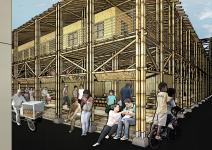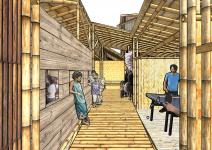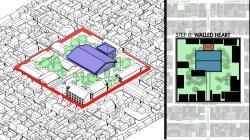At the core of my project is a desire to understand what is the city like today in the Philippines,
a country that has gone through explosive growth in the past three decades.
I did my investigation in the context of Metro Cebu, the second largest metropolitan area in the Philippine archipelago.
In order to grasp the character of the contemporary Philippine city, I focused my attention on a case study of a particular kind of development,
this is the Cebu Bussiness District, the most significant business hub of the Philippines outside of Metro Manila.
I conceptualize Cebu Bussiness District as a 'walled city within the city'.
It is a ‘work, live, play’ space that contains within itself all of the primary urban functions.
It has residential condominiums, it has office towers it has some open green space.
And at the core is its cathedral, it’s palace, it’s forum, and it’s marketplace – the Mega Shopping mall.
CBD is a paradox – a place that is globally hyper-connected but completely walled off from its immediate surroundings.
This kind of development can be found all over the archipelago.
It's an example of the powerful oligarchy of corporations imposing their will into the urban fabric.
But there is another side to the coin of the Philippine city.
There is a strange oval cutting into the Cebu Business district; this is Hipodromo.
This neighborhood was created by the victims of an earthquake colonizing an abandoned horse racing tracks of the city, hence the name - Hipodromo.
Throughout the years Hipodromo has developed into a thriving, tight-knit community almost like ‘a village within the city.’
Hipodromo is an example of the kind of vitality that can emerge from the grassroots when the most disadvantaged of citizens come together.
However, the Hipodromo community faces its fair share of problems.
For example, the heart of the neighboorhood, a large central block containing the school, the park and the municipal building is surrounded by a wall.
This central block is the only communal space in this neighborhood carved out of the dense field of private single-family houses.
The wall around the central block represents an obstacle for the public life of the neighborhood to fully develop.
Active public life is crucial for maintaining a sense of community and ownership, the greatest asset keeping this neighborhood from being swallowed by the surrounding business district.
My idea is to transform this wall around the heart of Hipodromo into a new structure, to create a sort of an inhabited border along the edge of this central block.
A structure will be able to provide the protective enclosure for the school and the park inside while also creating a new environment along the edge within which the public life of the community can unfold.
You can watch a short film I made as a presentation of my project here:
https://www.youtube.com/watch?v=xXeQRJhtvVY
Working on this thesis sparked a question in me: what are we do with the walls and borders of the city?
It is easy to build a wall or to simply tear one down, but walls are often there for a reason. I believe that the greatest challenge for the cities of the future will be to build better borders, dynamic and sophisticated able to provide the necessary clarity and protection while allowing for communication between different parts.
2018
0000
Miona Petkovic
Favorited 1 times




















